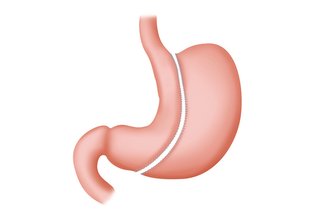Types of weight loss surgery and what happens
Gastric bypass, gastric band and gastrectomy weight loss surgery are all done by a surgeon using keyhole surgery. Endoscopic sleeve gastroplasty is done by passing a flexible tube (endoscope) into your mouth and down to your stomach.
All these types of weight loss surgery are done while you're under general anaesthetic (asleep).
Gastric bypass (Roux-en-Y)
Your stomach is divided in 2 using a stomach staple. This creates a small pouch at the top of the stomach. The new stomach pouch is then attached to the lower part of your small intestine.
After surgery, food passes from your stomach pouch to the lower part of your small intestine.
The operation usually takes around 2 hours.
Biliopancreatic diversion and duodenal bypass surgery are similar types of surgery, but less common. They both involve having part of the stomach removed.

Biliopancreatic diversion or duodenal bypass
These procedures are similar to a gastric bypass, but the stomach pouch is connected further along the small intestine.
They can cause more side effects than a gastric bypass, so are less commonly used.
Gastric band
An empty silicone tube (band) is placed around the top of the stomach.
At one end of the tube is a port. This is used to inflate the band. As air is pumped into the tube via the port, it tightens like a belt to create 2 smaller stomach areas.
Afterwards, the port stays just under the skin.
The operation usually takes 3 to 4 hours.

Sleeve gastrectomy (gastric sleeve)
Surgery starts with about 5 small cuts to your tummy. It's then filled with air so the surgeon is able to remove part of the stomach.
Around 80% of the stomach is removed to make it much smaller and a sleeve shape.
The operation usually takes 1 to 3 hours.

Gastric balloon
Before the procedure, a thin flexible telescopic camera is passed through your mouth into your stomach. It checks for things that would cause problems, like an ulcer or a large hiatus hernia.
After the camera is removed, you'll swallow the empty balloon. It will have a thin tube attached to it that fills the balloon with salt water when it's in place in your stomach.
It usually takes around 20 minutes.
You may be offered a local anaesthetic or sedative.
Endoscopic sleeve gastroplasty
A thin, flexible tube that has a camera inside and a special stitching device on the end is passed into your mouth and down to your stomach.
The stitching device is used to make 1 or more large folds in the stomach and sew them together. This can reduce the size of the stomach by up to 80%.
You can usually go home on the same day as the procedure, but some people may be kept in hospital overnight.
As no cuts or staples are used, and none of the stomach is removed, it may be possible to reverse this procedure later if needed.